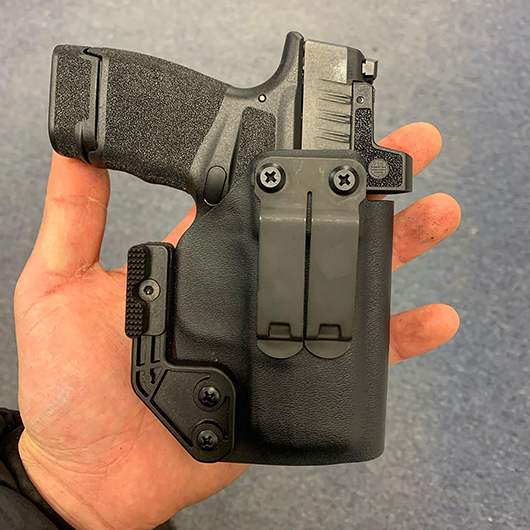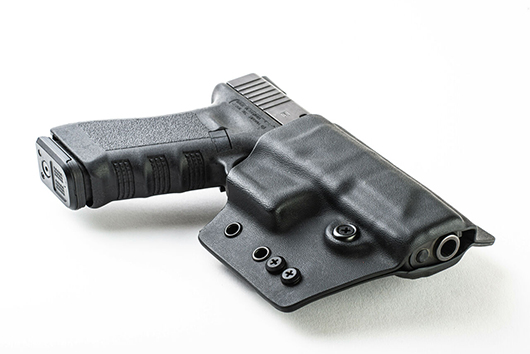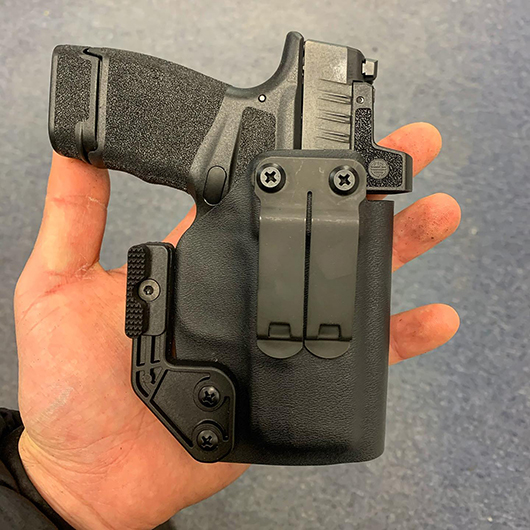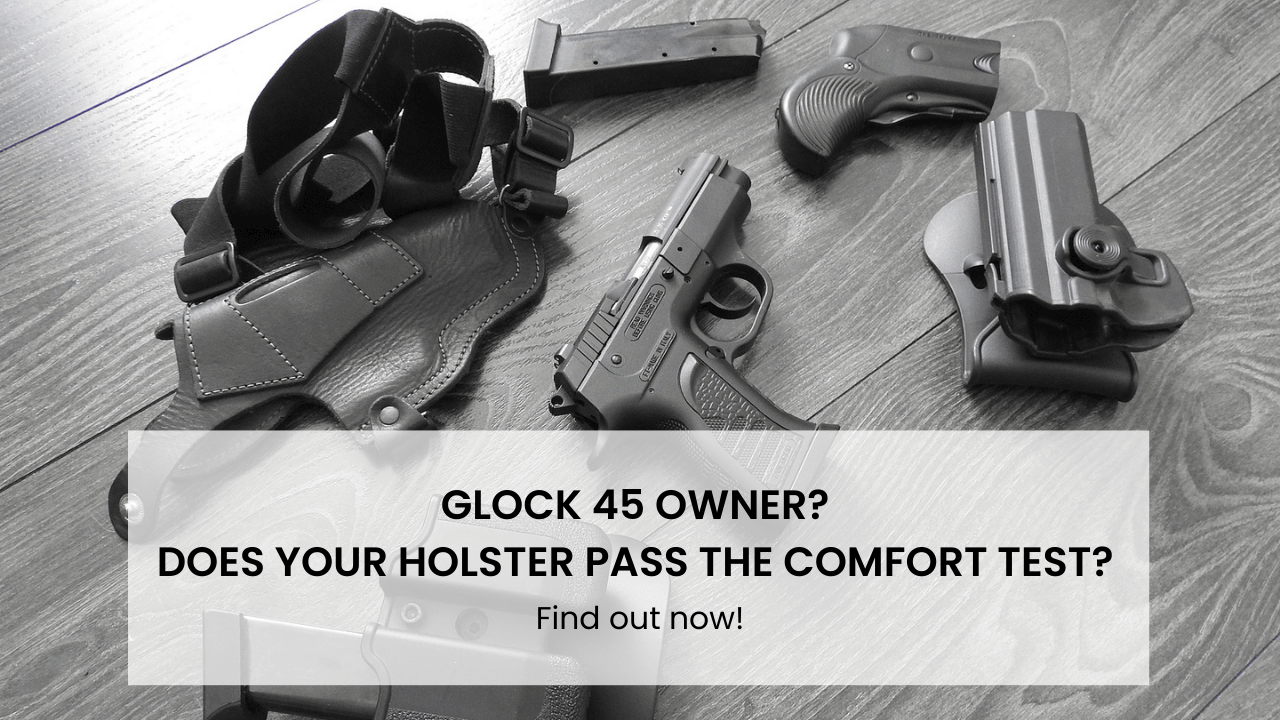P365 IWB Holster: What Features Do You Really Need?
Nov 7th 2021

If you own a SIG P365 for self-defense, a reliable, high-quality concealed carry holster is one of the most useful accessories you can buy. Not all holsters are created alike, and there are many options available, so it’s important to determine what’s useful and what isn’t to find the most practical option for self-defense.
SIG P365
The SIG Sauer P365 is a polymer-framed, striker-fired semi-automatic pistol series introduced in 2018 and available in four variants. Specifically designed for concealed carry, the P365 is lightweight and has few external controls.
P365 Micro Compact
The Micro Compact has a 3.1” barrel, an overall length of 5.8”, a width of 1”, a height of 4.3”, and a weight of 17.8 oz. Similarly sized to the Glock 43, the Micro Compact has a distinct advantage in magazine capacity: 10+1 vs. 6+1.
P365 SAS (SIG Anti Snag)
The SAS variant substitutes the low-profile FT Bullseye sighting system, eliminating the need for a front sight and reducing the pistol’s height by two-tenths of an inch (4.1”). The SAS is identical to the Micro Compact in barrel and overall length, width, weight, and magazine capacity.
P365 X
The X variant has an overall length of 6”, a width of 1.1”, and a height of 4.8”. The barrel length and weight remain the same as the MC and SAS. The XSeries Grip Module allows this variant to accept a flush-fit 12-round magazine, increasing available firepower.
P365 XL
The XL has a barrel length of 3.7”, an overall length of 6.6”, and the same width and height as the X (1.1” and 4.8”, respectively). However, the XL is heavier at 20.7 oz. While the MC and X variants have a sight radius of 4.9”, the XL extends this to 5.6”. Combined with the increased weight and barrel length, the XL increases shooting comfort without compromising concealability.
What Do You Need?
When you’re searching for a holster for your SIG P365, there are several essential criteria to consider.
Retention
For a holster to be suitable for self-defense, it needs sufficient, but not excessive, room to hold your weapon securely in place. In IWB and OWB holsters, retention may be active or passive, depending on your specific requirements.
Active retention
Active retention requires you to manually deactivate a fastener or locking mechanism to draw the firearm. Common examples include thumb breaks, retention straps, buttons, levers, and rotating hoods. When you carry a firearm openly (e.g., in a law enforcement capacity), an active retention holster reduces the risk of disarmament. However, it also requires additional training to master.
Passive retention
Passive retention secures the firearm via friction, requiring only upward pressure to break the gun free. The interior surfaces of the holster fit tightly against the exterior surfaces of the handgun. The result is a simple, quick draw stroke. In IWB (inside-the-waistband) holsters, passive retention is usually sufficient, as the need to protect against disarmament is lessened.
Kydex holsters are thermoformed to the exterior dimensions of the firearm, providing a highly retentive holster that you can typically tighten or loosen using one or more screws.
Safety
Every gun owner who carries a firearm should understand the four basic rules of gun safety. However, a holster can still be unsafe if poorly constructed or fails to protect the trigger adequately.
Rigid holster mouth
The construction of your holster plays a role in its safety. Regardless of why you’re carrying a handgun, your holster should have a rigid mouth that retains its shape and remains open when empty.
A holster mouth that collapses as you draw and requires the use of two hands for re-holstering is a potential liability. The risks associated with the re-holstering process are high, especially when you’re carrying your weapon AIWB (appendix inside the waistband).
If you experience an unintentional discharge when carrying in this position, whether accidental or negligent, your risk of incurring serious injury or death is higher than when carrying strong side. This is because the muzzle is pointed toward your groin and femoral artery.
Pliable holster materials, such as chamois leather, are unsuitable for this purpose. Leather holsters can be rigidly constructed and safe, but Kydex holsters are more resistant to moisture and chemical solvents. As a result, Kydex is less likely to deform.
Trigger coverage
The holster should fully enclose the trigger guard to prevent your index finger from entering the trigger guard and contacting the trigger during the draw stroke. The holster should also protect the trigger against foreign debris entering the trigger guard.
In many modern semi-automatic pistols, including the P365, there is no manual safety lever. As a result, anything that applies pressure to the trigger as you return the gun to its holster can potentially cause an unintentional discharge.
Concealability
One of the primary selling points regarding the P365 Micro Compact is its concealability. However, it isn’t strictly the bulk of the firearm that determines how effectively you can conceal it on your person. The holster type, where you carry the weapon on your body, how you dress, and the cant and ride height of the holster increase or reduce concealability.
An IWB holster is more concealable than an OWB holster. A low-profile holster design complements your carry method and position to reduce printing.
Printing is when the firearm or holster forms a visible outline through fabric. While this may simply go unnoticed by most bystanders, those experienced with firearms and concealed carry can detect that you’re armed.
Concealment accessories
If you need to conceal your firearm more effectively, you can attach a concealment accessory. A claw or wing attaches to the holster and drives the holster into your body and away from your waistband for a less revealing fit.
Tuckable holsters
IWB holsters are already among the most concealable waistband holster types available, but you can increase this further by purchasing a tuckable holster. A tuckable holster lets you tuck the fabric of a shirt into your waistband, over the holster, and into a space formed by the belt clips.
By carrying a tuckable holster, you can discreetly carry your firearm without compromising your wardrobe or violating work-related dress codes. When you need to draw your weapon, simply grip your shirt with two hands and pull upward to expose your holster.
Comfort
While comfort is sometimes dismissed as unimportant in a concealed-carry holster, there’s no reason to ignore this factor. You are less likely to carry an uncomfortable holster consistently.
Adjustability
You should be able to adjust the retention, ride height, and cant of the holster to maximize both comfort and concealability.
Ride height and cant
The ride height of your holster describes how low or high the holster sits inside or outside your waistband relative to the centerline of your gun belt. This increases or decreases the space between the front strap of the frame and the belt, which affects your ability to acquire a full firing grip on the weapon.
The cant describes the angle of the weapon relative to the centerline of your gun belt. A forward cant is generally considered preferable for strong side carry because it balances both concealment and accessibility. If you carry in the appendix position, you’ll need a neutral cant, in which the muzzle is perpendicular.
When you’re adjusting the ride height and cant of your holster, it’s important to strike a balance to maximize concealment and reduce printing.
Different Holster Types
The number of holster options available for both the SIG P365 and other concealed carry handguns is staggering. To find the most suitable SIG P365 holsters, you’ll need to determine how you want to carry your weapon. Holsters fall into two broad categories: Waistband and non-waistband.
Non-waistband holsters
Carrying firearms in non-waistband holsters has appeal for certain specialized applications. Some common examples include:
Ankle holsters
The P365 Micro Compact is highly concealable, leading some gun owners to consider carrying it as a backup gun in an ankle holster. You typically wear an ankle holster on the inside of your non-dominant leg, drawing with your strong hand.
However, while the MC is suitable for various holster types, ankle holsters are among the least efficient for general carry, as they’re slow to draw from.
Shoulder holsters
Shoulder holsters are suitable for some specialized applications, such as when driving for long periods. However, shoulder holsters require you to use two hands to re-holster your weapon and may inadvertently point straight at bystanders behind you.
Waistband holsters

Waistband holsters can be divided into two types: IWB and OWB. IWB holsters attach to the belt using one or two belt clips, whereas OWB holsters generally use integral or separately attached loops. While IWB is ideal for concealed carry, especially compact and subcompact firearms, OWB is suitable for open and concealed carry with many weapons, including full-size handguns. As the P365 series is designed for concealed carry, prioritizing lightweight and compact design, an IWB holster is the most discreet type of holster.
You can carry a waistband holster in one of several different positions:
Strong side
In the strong-side carry position, which is the most common, you place the holster on or behind your dominant or strong-side hip. If you’re a right-handed shooter, your strong side is generally between 3 and 5 o’clock. For left-handed shooters, it would normally be between 7 and 9 o’clock.
Strong side carry balances accessibility and concealment, allowing you to draw your weapon efficiently under a wide variety of circumstances. You can blade your body toward the target, using your support hand to keep the threat away from your firearm. It’s also effective for firing from retention.
Appendix
When you carry a handgun between 11 and 1 o’clock, this is called appendix carry. AIWB combines this position with an inside-the-waistband holster. AIWB is popular and offers a high degree of concealment for compact carry guns. Neither appendix carry nor IWB holsters are compatible with every body type, so you may need to experiment to find the best option.
Small of the back
In the small-of-the back position, on or beside your spine — approx. 6 o’clock. Small-of-the-back carry can effectively conceal compact firearms, but if you’re struck from behind or fall on your weapon, you risk suffering a serious injury to your vertebrae.
Cross draw
In the cross-draw position, you carry your weapon on your non-dominant hip, or between your hip and navel, with the butt facing forward or toward your strong side. Cross draw can be useful for those who sit behind a desk or spend hours driving every day. This position may also be beneficial for those who use a wheelchair.
Find the Best SIG IWB Holsters
At Incognito Concealment, we offer a variety of holsters suitable for both open and concealed carry. For the SIG P365, our Incognito IWB holsters combine durability, reliability, and ergonomic design for a perfect fit every time.
Call us at (586) 333-4240, and we’ll help you find the best holster type for your SIG pistol, regardless of the variant.











